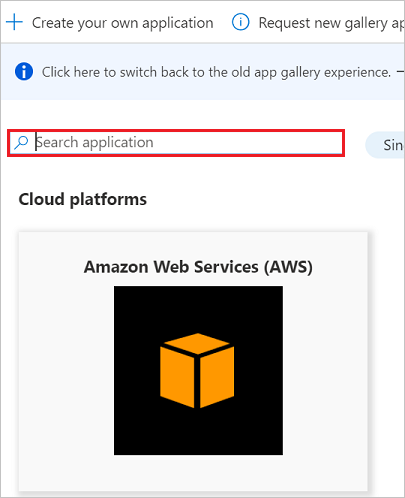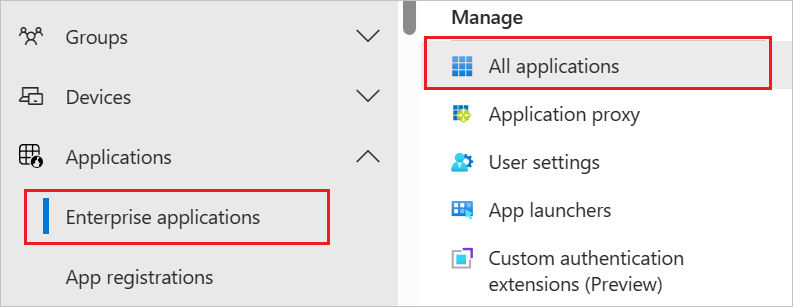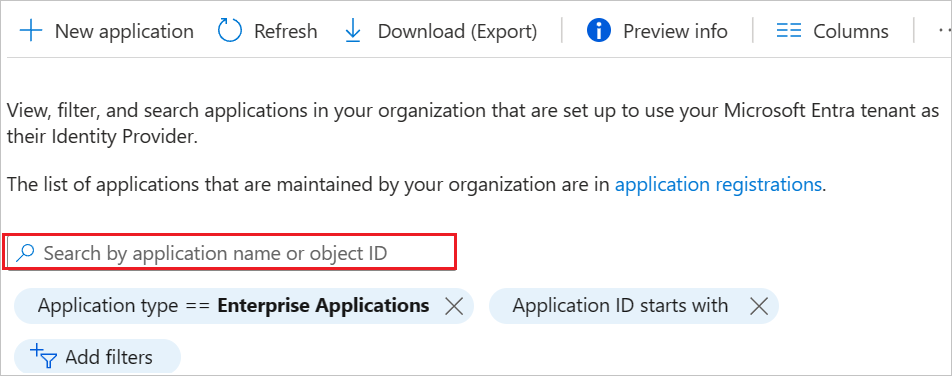Configure Infor CloudSuite for automatic user provisioning
The objective of this article is to demonstrate the steps to be performed in Infor CloudSuite and Microsoft Entra ID to configure Microsoft Entra ID to automatically provision and de-provision users and/or groups to Infor CloudSuite.
Note
This article describes a connector built on top of the Microsoft Entra user Provisioning Service. For important details on what this service does, how it works, and frequently asked questions, see Automate user provisioning and deprovisioning to SaaS applications with Microsoft Entra ID.
Prerequisites
The scenario outlined in this article assumes that you already have the following prerequisites:
- A Microsoft Entra tenant
- An Infor CloudSuite tenant
- A user account in Infor CloudSuite with Admin permissions.
Assigning users to Infor CloudSuite
Microsoft Entra ID uses a concept called assignments to determine which users should receive access to selected apps. In the context of automatic user provisioning, only the users and/or groups that have been assigned to an application in Microsoft Entra ID are synchronized.
Before configuring and enabling automatic user provisioning, you should decide which users and/or groups in Microsoft Entra ID need access to Infor CloudSuite. Once decided, you can assign these users and/or groups to Infor CloudSuite by following the instructions here:
Important tips for assigning users to Infor CloudSuite
It is recommended that a single Microsoft Entra user is assigned to Infor CloudSuite to test the automatic user provisioning configuration. Additional users and/or groups may be assigned later.
When assigning a user to Infor CloudSuite, you must select any valid application-specific role (if available) in the assignment dialog. Users with the Default Access role are excluded from provisioning.
Set up Infor CloudSuite for provisioning
Sign in to your Infor CloudSuite Admin Console. Click on the user icon and then navigate to user management.

Click on the menu icon on the left top corner of the screen. Click on Manage.

Navigate to SCIM Accounts.

Add an admin user by clicking on the plus icon. Provide a SCIM Password and type the same password under Confirm Password. Click on the folder icon to save the password. You will then see an User Identifier generated for the admin user.


To generate the bearer token, copy the User Identifier and SCIM Password. Paste them in notepad++ separated by a colon. Encode the string value by navigating to Plugins > MIME Tools > Basic64 Encode.

To generate the bearer token using PowerShell instead of Notepad++, use the following commands:
$Identifier = "<User Identifier>" $SCIMPassword = "<SCIM Password>" $bytes = [System.Text.Encoding]::UTF8.GetBytes($($Identifier):$($SCIMPassword)) [Convert]::ToBase64String($bytes)Copy the bearer token. This value will be entered in the Secret Token field in the Provisioning tab of your Infor CloudSuite application.
Add Infor CloudSuite from the gallery
Before configuring Infor CloudSuite for automatic user provisioning with Microsoft Entra ID, you need to add Infor CloudSuite from the Microsoft Entra application gallery to your list of managed SaaS applications.
To add Infor CloudSuite from the Microsoft Entra application gallery, perform the following steps:
- Sign in to the Microsoft Entra admin center as at least a Cloud Application Administrator.
- Browse to Identity > Applications > Enterprise applications > New application.
- In the Add from the gallery section, type Infor CloudSuite, select Infor CloudSuite in the search box.
- Select Infor CloudSuite from results panel and then add the app. Wait a few seconds while the app is added to your tenant.

Configuring automatic user provisioning to Infor CloudSuite
This section guides you through the steps to configure the Microsoft Entra provisioning service to create, update, and disable users and/or groups in Infor CloudSuite based on user and/or group assignments in Microsoft Entra ID.
Tip
You may also choose to enable SAML-based single sign-on for Infor CloudSuite, following the instructions provided in the Infor CloudSuite Single sign-on article. Single sign-on can be configured independently of automatic user provisioning, though these two features complement each other.
To configure automatic user provisioning for Infor CloudSuite in Microsoft Entra ID:
Sign in to the Microsoft Entra admin center as at least a Cloud Application Administrator.
Browse to Identity > Applications > Enterprise applications

In the applications list, select Infor CloudSuite.

Select the Provisioning tab.

Set the Provisioning Mode to Automatic.

Under the Admin Credentials section, input
https://mingle-t20b-scim.mingle.awsdev.infor.com/INFORSTS_TST/v2/scimin Tenant URL. Input the bearer token value retrieved earlier in Secret Token. Click Test Connection to ensure Microsoft Entra ID can connect to Infor CloudSuite. If the connection fails, ensure your Infor CloudSuite account has Admin permissions and try again.
In the Notification Email field, enter the email address of a person or group who should receive the provisioning error notifications and check the checkbox - Send an email notification when a failure occurs.

Click Save.
Under the Mappings section, select Synchronize Microsoft Entra users to Infor CloudSuite.
Review the user attributes that are synchronized from Microsoft Entra ID to Infor CloudSuite in the Attribute Mapping section. The attributes selected as Matching properties are used to match the user accounts in Infor CloudSuite for update operations. Select the Save button to commit any changes.
Attribute Type Supported for filtering Required by Infor CloudSuite userName String ✓ ✓ active Boolean displayName String externalId String name.familyName String name.givenName String displayName String title String emails[type eq "work"].value String urn:ietf:params:scim:schemas:extension:enterprise:2.0:User:manager String urn:ietf:params:scim:schemas:extension:enterprise:2.0:User:department String urn:ietf:params:scim:schemas:extension:infor:2.0:User:actorId String urn:ietf:params:scim:schemas:extension:infor:2.0:User:federationId String urn:ietf:params:scim:schemas:extension:infor:2.0:User:ifsPersonId String urn:ietf:params:scim:schemas:extension:infor:2.0:User:lnUser String urn:ietf:params:scim:schemas:extension:infor:2.0:User:userAlias String Under the Mappings section, select Synchronize Microsoft Entra groups to Infor CloudSuite.
Review the group attributes that are synchronized from Microsoft Entra ID to Infor CloudSuite in the Attribute Mapping section. The attributes selected as Matching properties are used to match the groups in Infor CloudSuite for update operations. Select the Save button to commit any changes.
Attribute Type Supported for filtering Required by Infor CloudSuite displayName String ✓ ✓ members Reference externalId String To configure scoping filters, refer to the following instructions provided in the Scoping filter article.
To enable the Microsoft Entra provisioning service for Infor CloudSuite, change the Provisioning Status to On in the Settings section.

Define the users and/or groups that you would like to provision to Infor CloudSuite by choosing the desired values in Scope in the Settings section.

When you are ready to provision, click Save.

This operation starts the initial synchronization cycle of all users defined in Scope in the Settings section. The initial cycle takes longer to perform than subsequent cycles, which occur approximately every 40 minutes as long as the Microsoft Entra provisioning service is running.
Step 6: Monitor your deployment
Once you've configured provisioning, use the following resources to monitor your deployment:
- Use the provisioning logs to determine which users have been provisioned successfully or unsuccessfully
- Check the progress bar to see the status of the provisioning cycle and how close it's to completion
- If the provisioning configuration seems to be in an unhealthy state, the application goes into quarantine. Learn more about quarantine states here.
Change log
02/15/2023 - Added support for custom extension user attributes urn:ietf:params:scim:schemas:extension:infor:2.0:User:actorId, urn:ietf:params:scim:schemas:extension:infor:2.0:User:federationId, urn:ietf:params:scim:schemas:extension:infor:2.0:User:ifsPersonId, urn:ietf:params:scim:schemas:extension:infor:2.0:User:inUser, and urn:ietf:params:scim:schemas:extension:infor:2.0:User:userAlias.
More resources
- Managing user account provisioning for Enterprise Apps
- What is application access and single sign-on with Microsoft Entra ID?